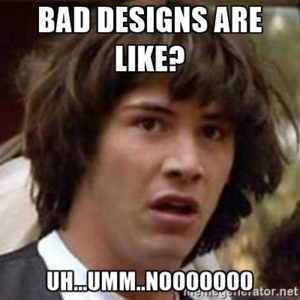
Dollars and Design: Counting the Cost of Poor App Design on Your Bottom Line
Unlock the secrets behind the financial pitfalls of poorly designed apps. Dive into our blog to understand the real costs, from plummeting user retention and brand damage to increased customer acquisition expenses. Discover how ScaleNow Tech can transform your app design, ensuring a positive impact on your business's bottom line. Get a quote for your next app with us and turn your digital vision into a success story!
The Domino Effect: How App Design Impacts Your Bottom Line
In a world where seamless interactions and user-friendly interfaces are the currency of success, the characteristics of a poorly-designed app stand out like sore thumbs in the digital landscape. Brace yourself for a journey into the pitfalls and perils of subpar app design, where glitches, frustrations, and missed opportunities become the unwelcome companions of unsuspecting users.
Navigating the Hazards of Bad App Experiences

A poorly designed app can be viewed from various perspectives, each shedding light on different aspects of its inadequacies. Here are the following:
User Experience Perspective:
- Glitchy Interfaces: A poorly designed app often exhibits frequent glitches, crashes, or freezes, disrupting the user experience and causing frustration.

- Confusing Navigation: Complex and unclear navigation structures make it challenging for users to find what they're looking for, leading to a frustrating experience.
- Slow Performance: Laggy response times and slow loading can significantly diminish user satisfaction and engagement.
Visual Design Perspective:

- Inconsistent Branding: A lack of cohesive branding elements, such as colors, fonts, and imagery, can dilute the brand identity and create a disjointed visual experience.
- Cluttered Layouts: Overcrowded screens with excessive information or poorly organized content can overwhelm users and hinder readability.
Functionality Perspective:
- Bugs and Crashes: A poorly designed app is prone to bugs, crashes, and technical issues, undermining its reliability and functionality.
- Limited Features: Insufficient or poorly implemented features can leave users wanting more, diminishing the app's overall utility.
Security Perspective:

- Vulnerability to Threats: Security loopholes and inadequate measures can expose user data to potential breaches, eroding trust and tarnishing the app's reputation.
- Lack of Encryption: Failing to implement robust encryption protocols can compromise the confidentiality of sensitive user information.
Accessibility Perspective:
- Poor Accessibility Features: Ignoring accessibility standards can exclude users with disabilities, leading to a lack of inclusivity and potential legal issues.
- User Frustration and Abandonment: Users encountering accessibility barriers are likely to experience frustration, leading to a high bounce rate and potential abandonment of the app. This negative user experience can have a lasting impact on their perception of the brand.
Business Perspective:

- Negative Impact on Reputation: A poorly designed app reflects poorly on the business, damaging its reputation and potentially leading to customer churn.
- Lost Revenue Opportunities: Users are less likely to engage with an app that doesn't meet their expectations, resulting in lost revenue opportunities.
Development Perspective:
- Inefficient Code: Poorly optimized and inefficient code can lead to performance issues, longer loading times, and difficulties in maintaining and updating the app.
- Lack of Scalability: Apps that are not designed with scalability in mind may struggle to accommodate growing user bases or evolving business needs.
The Fallout: The Multi-Dimensional Impact of Bad App Design

A poorly designed app can have a profound and detrimental impact on a business across multiple dimensions. From high bounce rates and low user retention to negative brand perception and decreased conversion rates, the repercussions are far-reaching. Users encountering frustration or confusion are likely to abandon the app swiftly, leading to diminished brand loyalty and a tarnished reputation. The associated decline in conversion rates directly affects revenue, while negative reviews further impede user acquisition. Increased customer acquisition costs and higher customer support expenses add financial strain. Additionally, the app's inability to capitalize on monetization opportunities and difficulty in scaling hinder the business's growth potential. In a competitive digital landscape, where user experience is paramount, a poorly designed app stands as a significant obstacle to a business's success, both operationally and strategically.
1. High Bounce Rates:
Impact: A poorly designed app often leads to a high bounce rate, where users quickly abandon the app after experiencing usability issues or frustration. Consequence: High bounce rates can negatively affect the app's visibility in app stores and search engines, impacting overall discoverability and user acquisition.
2. Low User Retention:
Impact: Users are less likely to stick around if the app fails to provide a positive and enjoyable experience. Consequence: Low retention rates signal a struggle to retain a loyal user base, affecting long-term engagement, repeat usage, and potential monetization opportunities.
3. Negative Brand Perception:
Impact: A poorly designed app reflects poorly on the brand, signaling a lack of commitment to quality and user satisfaction. Consequence: Negative brand perception can lead to a decline in brand loyalty, trust, and overall brand recognition, affecting the business's reputation.
4. Decreased Conversion Rates (CTR):
Impact: Usability issues, confusing interfaces, or slow performance can deter users from completing desired actions within the app. Consequence: A decrease in conversion rates directly affects the app's ability to convert users into customers, impacting revenue generation and business growth.
5. Increased Customer Acquisition Costs (CAC):
Impact: Users dissatisfied with the app experience are less likely to convert, increasing the cost of acquiring new customers to compensate for high churn rates. Consequence: Elevated CAC can strain marketing budgets and hinder the cost-effectiveness of user acquisition strategies.
6. Poor User Reviews and Ratings:
Impact: Users experiencing frustration are more likely to leave negative reviews and low ratings on app stores. Consequence: Negative reviews can deter potential users from downloading the app, creating a cycle of poor reputation and reduced trust.
7. Limited Word-of-Mouth Marketing:
Impact: Satisfied users are less likely to recommend an app with a poor UX to others. Consequence: Limited positive word-of-mouth marketing hampers organic user acquisition, making it challenging to expand the user base through referrals.
8. Higher Customer Support Costs:
Impact: Usability issues and frustrations often lead to an increase in customer support inquiries. Consequence: Higher customer support costs strain resources and divert attention from strategic business initiatives, impacting overall operational efficiency.
9. Missed Monetization Opportunities:
Impact: A poorly designed app may struggle to implement effective monetization strategies. Consequence: Missed opportunities for in-app purchases, subscriptions, or advertising revenue contribute to financial challenges for the business.
10. Difficulty in Scaling:
Impact: A poorly designed app may face challenges in accommodating a growing user base. Consequence: Difficulty in scaling hinders the app's ability to capitalize on expanding market opportunities, limiting the business's potential for growth.
Bottom Line:
In the dynamic world of digital landscapes, your app's design is the unsung hero or the villain in your business story. As we unravel the perils of a poorly designed app, it's clear that the stakes are high—from bouncing users to bruised brands and diminished revenues. But fear not! Your business deserves more than just survival; it deserves to thrive. Let's turn the page on design disasters. At ScaleNow Tech, we're not just developers; we're creators of digital experiences. Ready to transform your app into a masterpiece? Get a quote from Scalenowtech—where brilliance meets technology! Your journey to a stellar app experience begins here.
Related Blogs
Coming soon...
.85bbfc68.png&w=640&q=75)

.0df94cc1.png&w=256&q=75)

